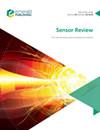Noise measurement and system calibration on magnetoresistive sensors
IF 1.4
4区 工程技术
Q3 INSTRUMENTS & INSTRUMENTATION
引用次数: 1
Abstract
Purpose The noise measurement on magnetoresistive (MR) sensors is generally conducted by techniques including single-channel data sampling and fast Fourier transform (FFT) analysis as well as two-channel cross-correlation. The single-channel method is easy to implement and is widely used in the noise measurement on MR sensors, whereas the two-channel method can only eliminate part of the system noise. This study aims to address two key issues affecting measurement accuracy: calibration of the measurement system and the elimination of system noise. Design/methodology/approach The system is calibrated by using a low-noise metal film resistor in that the system noise is eliminated through power spectrum subtraction. Noise measurement and analysis are conducted for both thermal noise and detectivity of magnetic tunnel junction (MTJ) sensor. Findings The thermal noise measurement error is less than 2%. The detectivity of the MTJ sensor reaches 27 pT/Hz1/2 at 2 kHz. Originality/value This study provides a more practical solution for noise measurement and system calibration on MR sensors with a bias voltage and magnetic field.磁阻传感器的噪声测量与系统校准
目的磁阻传感器的噪声测量一般采用单通道数据采样、快速傅里叶变换(FFT)分析和双通道互相关等技术。单通道方法易于实现,广泛应用于磁阻传感器的噪声测量中,而双通道方法只能消除部分系统噪声。本研究旨在解决影响测量精度的两个关键问题:测量系统的校准和系统噪声的消除。设计/方法/方法系统采用低噪声金属膜电阻进行校准,通过功率谱减法消除系统噪声。对磁隧道结(MTJ)传感器的热噪声和探测性进行了噪声测量和分析。结果:热噪声测量误差小于2%。在2khz时,MTJ传感器的探测率达到27pt /Hz1/2。独创性/价值本研究为具有偏置电压和磁场的磁磁共振传感器的噪声测量和系统校准提供了一个更实用的解决方案。
本文章由计算机程序翻译,如有差异,请以英文原文为准。
求助全文
约1分钟内获得全文
求助全文
来源期刊

Sensor Review
工程技术-仪器仪表
CiteScore
3.40
自引率
6.20%
发文量
50
审稿时长
3.7 months
期刊介绍:
Sensor Review publishes peer reviewed state-of-the-art articles and specially commissioned technology reviews. Each issue of this multidisciplinary journal includes high quality original content covering all aspects of sensors and their applications, and reflecting the most interesting and strategically important research and development activities from around the world. Because of this, readers can stay at the very forefront of high technology sensor developments.
Emphasis is placed on detailed independent regular and review articles identifying the full range of sensors currently available for specific applications, as well as highlighting those areas of technology showing great potential for the future. The journal encourages authors to consider the practical and social implications of their articles.
All articles undergo a rigorous double-blind peer review process which involves an initial assessment of suitability of an article for the journal followed by sending it to, at least two reviewers in the field if deemed suitable.
Sensor Review’s coverage includes, but is not restricted to:
Mechanical sensors – position, displacement, proximity, velocity, acceleration, vibration, force, torque, pressure, and flow sensors
Electric and magnetic sensors – resistance, inductive, capacitive, piezoelectric, eddy-current, electromagnetic, photoelectric, and thermoelectric sensors
Temperature sensors, infrared sensors, humidity sensors
Optical, electro-optical and fibre-optic sensors and systems, photonic sensors
Biosensors, wearable and implantable sensors and systems, immunosensors
Gas and chemical sensors and systems, polymer sensors
Acoustic and ultrasonic sensors
Haptic sensors and devices
Smart and intelligent sensors and systems
Nanosensors, NEMS, MEMS, and BioMEMS
Quantum sensors
Sensor systems: sensor data fusion, signals, processing and interfacing, signal conditioning.
 求助内容:
求助内容: 应助结果提醒方式:
应助结果提醒方式:


